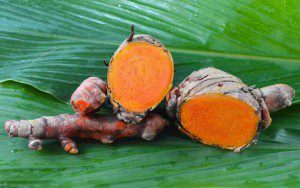By Sayer Ji
Contributing Writer for Wake Up World
Few, if any, plants have been revered as thoroughly — by the religious and scientific community alike — as a healer of the human body, mind and soul, as beautiful turmeric.
It could be written off as an overly imaginative cultural oddity that ancient Indians understood turmeric to be the physical essence of the Divine Mother — a botanical embodiment of compassion and healing. After all, nothing in the known biochemistry of this common spice plant lends itself to so gratuitous a characterization, does it?
It turns out that even modern science now confirm that this ‘curry’ spice has therapeutic properties relevant to well over 600 different health conditions, and may therefore bestow on those who take it significant protection from many common causes of human suffering. Some of the more amazing examples are its ability to reverse aspects of dementia (Alzheimer’s disease), replace Prozac, prevent type 2 diabetes, produce cardiovascular benefits as significant as exercise, including preventing post-bypass heart attack by 56%, heal the diabetic liver, kill lethal pancreatic cancer, and help kick painkillers to the curb for osteoarthritis and rheumatoid arthritis, while giving at least a dozen more pharmaceuticals a run for their money.
While these examples are not proof of ‘divine’ benevolence, they certainly raise some interesting questions, not the least of which is how any substance could be so well suited for improving human physical and mental health with such a depth and breadth of effectiveness.
The author has personally reviewed the majority of the biomedical abstracts on turmeric and its primary polyphenol curcumin, available to view on the National Library of Medicine’s bibliographic reference database known as MEDLINE (and searchable through engines like Pubmed.gov), and has been awed by how diverse and powerful this spice is for addressing the broad range of diseases and/or disease symptoms that commonly afflict our species.
[Note: this is an old video; membership prices/features no longer valid.]
One of the novel findings that emerged in the author’s comprehensive review of turmeric is that it can beneficially modulate over 175 distinct physiological actions, many of which operate upon traditional pharmacological pathways, e.g. interleukin-6 down-regulator, apoptotic, cyclooxygenase inhibitor, etc. During the indexing process the image emerged of a many-armed Indian Goddess, due to how diverse, intelligent and simultaneous are this spice’s healing gifts.
In fact, from the perspective of monochemical-oriented pharmacology, a drug with more than 10 simultaneously therapeutic actions, and without the vast array of adverse, unintended side effects commonly associated with novel, patentable chemicals, turmeric would represent an impossible, miraculous entity, which if patentable, would generate more revenue than all the blockbuster drugs on the market put together. Instead, sadly, most pharmaceuticals have dozens of side effects that are often more powerful than the purported therapeutic properties they possess.
Amazingly, a 2012 article published in the journal Nutrition and Cancer discovered that when a type of cancer cell (retinoblastoma) was exposed to the turmeric polyphenol curcumin, it altered the expression of over 2,000 genes! The authors describe the remarkably broad changes:
We identified 903 downregulated genes and 1,319 upregulated genes when compared with the control cells after treatment with 20 μM curcumin concentration for 48 h.
The amount of information that would be required to alter the expression of such a wide range of genes in a way that actually inhibited the viability of the cancer cells is staggering, and likely a reflection of a higher order level of intelligence that our present day theoretical and empirical scientific frameworks are not equipped to fully comprehend.
Is Turmeric Simply A Biochemical Entity, or Does it Contain “Intelligence” and “Compassion”?
After some reflection on the mass of data that accumulated on turmeric’s ability to alleviate suffering, the question emerged: are these many “evidence-based,” scientific studies really just exoteric descriptions of “compassion” and “intelligence”? Are we now rediscovering through the optic of modern science — albeit through the reductionist and animal sacrifice-based (vivisection) methodology of empirical science — the “spirit” of herbs like turmeric, whose very existence represent a kind of surplus of benevolent, regenerative energy that permeates the universe, bestowing its grace upon its inhabitants/creations? Is this not what the ancients meant, or saw, when they described the spice in Sanskrit as “Gauri” (“The One Whose Face is Light and Shining”) and “Kanchani” (“Golden Goddess”)?
Our turmeric database on GreenMedInfo.com (and by “our” I mean yours, as well, as this is an open source project) now contains the world’s largest archive of biomedical data on the subject of turmeric’s medical value in one place, and includes voluminous research on turmeric’s potential to prevent and/or treat multi-drug resistance cancers, chronic degenerative conditions, neurological problems, depression, serious infections, as well as hundreds of other diseases. Please share this information with others, especially those who need an “evidence-bridge” connecting ancient healing wisdom with the modern scientific approach.
Further articles by Sayer Ji:
- Research: Curcumin Is A Triple Negative Breast Cancer Killer
- The Spice That Prevents Fluoride From Destroying Your Brain
- Turmeric Beats Ibuprofen for Arthritis of the Knee
- Roundup Weedkiller Found In 75% of Air and Rain Samples, Government Study Finds
- Live Flu Vaccines Increase Infectious Bacteria Counts 100-Fold in Mice
- FAIL: Another Mammography Study Finds They Don’t Save Lives
- MSG Proven Highly Toxic: 1 Dose Causes Headache In Healthy Subjects
- Black Seed Extract ‘Cures’ HIV Patient Naturally
- The Grain That Damages The Human Brain
- The Cancer-Causing Metal Millions Eat, Wear or Have Injected Into Their Kids
- Biophotons: The Human Body Emits, Communicates with, and is Made from Light
- The 2013 Measles Outbreak: A Failing Vaccine, Not A Failure To Vaccinate
- 3 Evidence-Based Ways To Reverse Skin Aging Naturally
- Why Is The Food Industry Poisoning Us With Trillions of Nanoparticles?
- How to Clean Your Arteries With One Simple Fruit
- 13 Evidence-Based Medicinal Properties of Coconut Oil
About the author:
Sayer Ji is an author, educator, Steering Committee Member of the Global GMO Free Coalition (GGFC), advisory board member of the National Health Federation, and the founder of GreenMedInfo.com – an open access, evidence-based resource supporting natural and integrative modalities. His writings have been published and referenced widely in print and online, including Truthout, Mercola.com, The Journal of Gluten Sensitivity, New York Times and The Well Being Journal.
In 1995 Sayer received a BA degree in Philosophy from Rutgers University, where he studied under the American philosopher Dr. Bruce W. Wilshire, with a focus on the philosophy of science. In 1996, following residency at the Zen Mountain Monastery in upstate New York, he embarked on a 5 year journey of service as a counsellor-teacher and wilderness therapy specialist for various organizations that serve underprivileged and/or adjudicated populations. Since 2003, Sayer has served as a patient advocate and an educator and consultant for the natural health and wellness field.
Connect with Sayer Ji on Google Plus.

If you've ever found value in our articles, we'd greatly appreciate your support by purchasing Mindful Meditation Techniques for Kids - A Practical Guide for Adults to Empower Kids with the Gift of Inner Peace and Resilience for Life.
In the spirit of mindfulness, we encourage you to choose the paperback version. Delve into its pages away from screen glare and notifications, allowing yourself to fully immerse in the transformative practices within. The physical book enriches the learning process and serves as a tangible commitment to mindfulness, easily shared among family and friends.
Over the past few years, Wake Up World has faced significant online censorship, impacting our financial ability to stay online. Instead of soliciting donations, we're exploring win-win solutions with our readers to remain financially viable. Moving into book publishing, we hope to secure ongoing funds to continue our mission. With over 8,500 articles published in the past 13 years, we are committed to keeping our content free and accessible to everyone, without resorting to a paywall.








